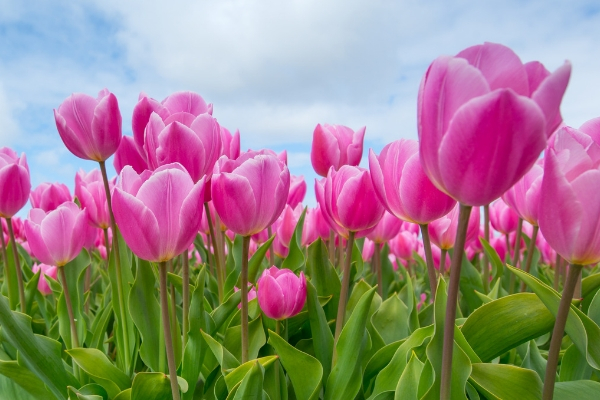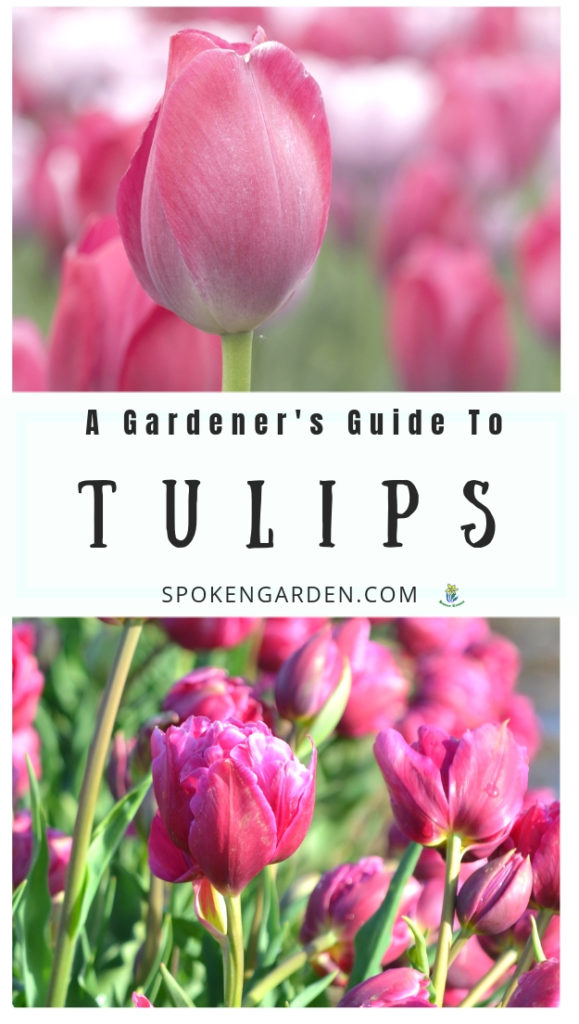Learn all about Tulip flowers in this gardener’s guide.
Tulips are one of the most popular flowers and help signal the start of the spring season with their colorful blooms and variety of sizes. See our bulb planting tool kit here!
With an estimated 3 billion bulbs exported each year, depending on your color or size preference there is sure to be a tulip flower for you.
Quick Plant Care Facts
| Sun Exposure | Full sun up to and during blooming. Part shade in hotter climates after blooming. |
| Water Needs | Regular watering is needed during growth and blooming. Once blooming has finished, not further watering is needed as bulbs go dormant over summer, fall, and winter months. |
| Soil Needs | A rich, sandy soil is best, but most tulips will grow in any well-draining soil. If planting new tulip bulbs where older ones have been or were growing, then either plant new bulbs in different location or replace old soil in that old location. |
| Cold-Hardiness Zones | USDA hardiness zones 4 to 10. |
| Bloom Time | March to May. |
| Flower Colors | Flowers come in most colors and in different color combinations due to a mosaic virus (not harmful to plants) that gives different color patterns in flower petals. |
| Mature Height/Width | Varies; can be from 6-inches up to 24+ inches in height. |
| Plant Spacing | Depends on bulb size. Need to plant each bulb twice as deep as the bulb is wide. Bulb spacing can be type-dependent, but a good rule of them is at least 4-6 inches for miniatures and smaller types, and up to 8-12 inches for larger plants types. |
If you are looking for Summer Flowering Bulbs to add to your garden, look no further than our ebook
21 Spring-Planted Bulbs For Fantastic Summer Color!
It’s has 60+ pages of summer flowering bulb inspiration and you can get to know the different plant care needs of these 21 gorgeous spring-
planted, summer-flowering bulbs. Whether you are already familiar with bulbs or are just learning about them, this guide explains what bulbs are, defines the 5 different types of bulbs, the correct planting orientation for each of the 5, and much more.
You also get to know each of these 21 spring-planted, summer-flowering bulbs intimately for their care needs like where they will grow, when they flower, different flower colors they are available in, and which online-retailers you can buy your very own to then add to your garden.
Grab your copy now and start planning your spring and summer flower garden TODAY!
A wonderful addition to any garden, tulips are low maintenance and offer spring color each season. If your flowers have tall stems that need support, be sure to use stakes to prop them up.
In our tulip plant profile below, you’ll learn what sets tulips (14 different kinds!) apart from other spring-blooming bulbs as well as basic plant care and where to buy them for yourself.
Read our Tulip plant post below to learn:
How to grow and care for tulips in your yard
- Where to buy tulips now
- History of tulips in Holland, and so much more!
Tulips: Why We’re Featuring This Plant For You
First, tulips announce the coming of spring.
With their bluish-green leaves and tall, graceful form, what better way to wake up the garden than with brightly-colored tulips?
In addition, tulips come in a variety of shapes, sizes, and colors.
Did you know there are 14 different types of tulips to choose from?
Plus, tulips are very low maintenance. So low maintenance, you might almost forget about them until they begin to burst out of the ground in early spring.
Finally, we’re featuring the tulip because of it’s unique history, especially in Holland, where it was once used as a currency.
Tulip Care
Tulip Flowers: History and Varieties
Tulip Family
Tulips are in the family Liliaceae and the genus Lilipa. This family group, also known as the Lily family, includes herbaceous and woody flowering plants ranging between garden favorites and wildflowers.
With over 700 species, many members of this family are valued for their ornamental plants and highly commercialized through the flower farming industry, or floriculture, for their cut flowers and dry bulbs.
Other members of the Liliaceae family include lilies, onions, garlic, and asparagus.
Tulip History
Throughout the years, tulips have led to economic instability, huge commercial industries, and a “mania” all due to their perceived importance.
Tulips have been cultivated since at least the tenth century. Wow!
They have a long cultural tradition, particularly in the Islamic world, where they are highly symbolic and used for decoration among other things.
Originating anywhere from Southern Europe to Central Asia, mainly Persia to Turkey, they were important to the art and culture of the Persian people and later the Ottoman Empire.
By the 16th century, tulips reached Europe and were first seen in the Netherlands in 1625 but also continued to grow in importance to the Ottomans.
Eventually, they became a national symbol of the Ottoman Empire and as the empire spread, so did tulip culture.
This period of history came to be known as the “Tulip Era.”
Tulips actually became so expensive and economically important, they were used as a form of currency!
As they continued their rapid spread across Europe, they made their way across the pond to America.
Today, the Netherlands is the world’s largest producer of tulips with an estimated 3 billion bulbs (that’s billion) exported annually.
Most tulips are loved and enjoyed around the world as spring garden staples and ornamental cut flowers.
Tulip Varieties
Did you know there are 14 different types of tulips to choose from?
They differ by flower form, size, bloom time, and stem length.
And of course, there are many different colors to choose from.
Tulip varieties:
- Darwin Hybrids
- Single Early
- Single Late
- Triumph
- Double Early and Late
- Fringed
- Fosteriana
- Greigii
- Kaufmanianna
- Lily Flowered
- Parrot
- French
- Viridiflora
- Botanical or Species
How To Grow Tulips
First of all, bulbs should be planted in the fall before the threat of the first frost. The month may vary depending on where you live.
Next, when you select your tulips, consider their flowering times, their suitability for borders, or containers.
Finally, select your bulbs carefully and only plant healthy bulbs. Inspect bulbs for moldy areas or other signs of damage before planting them in the ground.
Tulip Planting Steps:
- Plant bulbs at least twice the bulb’s width apart (about 4-6 inches)
- Plant at a depth of two or three times the bulb’s height (about 6-8 inches)
- Place the bulbs with the pointy end facing up
- For the soil, make sure you place them in sandy, well-drained soil
- Make sure they will have good sun exposure as they prefer full sun
- Water them thoroughly after planting, for live growing plants in the spring. If planting in the fall, no need to water them until late winter or early spring. Especially if it’s a dry.
After they have flowered, wait until the tulip flower, stem, and leaves have fully withered and turned brown before cutting the flower off. This will make sure the bulbs get all the nutrients from these plant tissues they need for next season’s growth. Click here for our favorite hand pruners to care for your tulips and other plants.
Also, you can cover the bulb area with 2-3 inches of mulch to keep it protected, healthy, and warm during the off-season.
Skagit Valley Tulip Festival
One of the greatest displays of tulips in the world takes place each April in the Skagit Valley.
Known as the Tulip Festival, tulips of various shapes, sizes, and colors grace the landscape and dazzle each spring.
Check out this quick video to see for yourself!
Tulip Bulbs vs. Store-Bought Tulips
Should you buy your tulips as bulbs or already grown and potted from the store?
Well, do you prefer to wait a bit or do you want instant gratification?
There are benefits to either, so it really just depends on your preference.
Benefits of Tulip Bulbs 
- Better selection and variety available to you
- Can be cheaper in cost
- Satisfying to nurture and watch grow
- Easy to maintain
- Can order online and have shipped to your house
Benefits of Store-bought Tulips
- Instant gratification
- Can re-plant in beds or containers and have instant color
- Easy to maintain
- Can hand-pick and choose your flower colors
- Can order online and have plants shipped to your house
Tulips For Sale
Now it’s time to pick out your own tulip bulbs to plant next fall or live tulips to place in your home now!
The best part is there are so many beautiful colors, shapes, and sizes available.
Below, we have both bulbs and live tulip plants for you to choose from depending on the color you prefer.
The gorgeous selection of bulbs come from Eden Brothers which we recommend. The bulbs are on pre-sale now and will ship in Fall 2019.
Our beautiful selection of live tulips come from Amazon and are all prime shipping so you can receive them quickly!
Pink Tulips
Red Tulips
White Tulips
Yellow Tulips
Purple Tulips
Or, if you need to shop for other garden plants for this spring, click the link below.
Tulip Plant Conclusion
Tulips are one of the most popular flowers and help signal the start of Spring season with their colorful blooms and variety of sizes.
Depending on your color or size preference, there is sure to be a tulip variety for you. A wonderful addition to any garden, tulips are low maintenance and offer spring color each season.
Now it is time to hear from you!
What color tulip do you want to plant in your own garden? Which variety are you interested in?
Leave a quick comment below and let us know!
Well, that’s all for now.
Thanks for reading and we hope you enjoyed our tulip plant profile.
Want to learn about other plants in your garden? Check out some of our previous plant profiles:
- Primroses: A Gardener’s Guide and Plant Profile
- The Gardener’s Guide to Dianthus
- The Gardener’s Guide to Chrysanthemums
- Roses: A Gardener’s Guide and Plant Profile
- Daffodils: A Gardener’s Guide and Plant Profile
See you in the garden!
~ Sean and Allison
P.S. Find us on Pinterest, Twitter, Facebook, and Instagram so you don’t miss a thing!
Tulip Plant References:
- “Tulips” (Tulipa) – Sunset Magazine
- “Tulips” – RHS
- “How to Care For Tulips” – Real Simple
All about spring tulips in this gardener’s guide of this beautiful plant.





